|
Weed Management
 |
|
Weed Flora in Rice Field |
 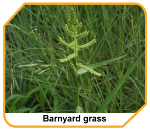
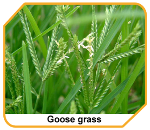  |
Grasses
- Echinocloa crusgalli ssp. Hispidula (Barn yard grass)
- Echinocloa colonum L. Link ( Jungle rice)
- Panicum repense L (Torpedo grass)
- Paspalum conjugatum Berg ( Hilo grass)
- Digitaria sanguinalis L. scop (Large crab grass)
- Eleucine indica L. Gaertn (Goose grass)
- Dactyloctenium aegyptium L. Beauv. (Crowfoot grass)
- Imperata cylindrica L. Beauv. (Cogon grass)
- Cynodon dactylon L. (Bermuda grass)
- Oryza rufipogon (brown beard rice)
- Saccolepis interrupta (polla)
- Isachne miliacea (chovverippullu, naringa)
- Echinochloa stagnina (Hippo grass)
|
Sedges
- Cyperus difformis L (Common sedge)
- Cyperus iria L. (Umbrella sedge)
- Fimbristylis milacea L.Vahl (Poonkorai)
- Scirpus maritimus L. ( Bull rush)
- Cyperus rotandus L. (Purple nut sedge)
|
 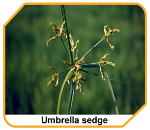 |
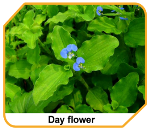 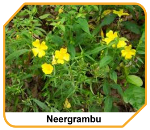
  |
Broad leaved weeds
- Monochoria vaginalis (Oval-leafed pondweed)
- Ludwigia parviflora L. Roxb
- Marselia quadrifolia L. ( Marsilea)
- Amaranthus spinosus L. Spiny amaranth
- Ageratum conyzoides L. Goat weed
- Celosia argentia L. ( Cox comb)
- Commelina benghalensis L. Day flower
- Eclipta alba (False Daisy)
- Portulaca oleracia L.Common purslane
- Trianthema portulacastrum L ( Horse purslane)
- Ludwigia perennis (neergrampu)
- Limnocharis flava (nagappola)
- Ammania baccifera (nellicheera)
|
Ferns
- Salvinia molesta (African payal)
- Marsilea quadrifolia (naalilakodian)
- Azolla pinnata (azola)
|
  |
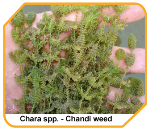  |
Algae
- Chara spp. (chandi)
- Spirogyra spp. (payal)
|
|
| |
Top |
| Critical Period of Weed Competition |
|
- The critical period of weed competition is the shortest time span during the crop growth when weeding results in highest economic returns.
- The crop yield level obtained by weeding during this period is almost similar to that obtained by the full seasons weed free conditions.
- The critical period of weed competition is approximately 1/3rd of the duration of the crop.
| Crops |
Critical period
(days after sowing) |
| Rice (Transplanted) |
15- 45 |
| Upland rice |
Entire period |
|
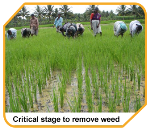 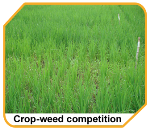

|
|
| Top |
| Weed Management Methods |
Weed control and weed management are the two terms used in weed science.
- Weed control is the process of limiting infestation of the weed plant so that crops can be grown profitably.
- Weed management includes prevention, eradication and control by regulated use, restricting invasion, suppression of growth, prevention of seed production and complete destruction.
|
Preventive methods
- Use of weed free seeds.
- Use of weed free seed bed.
- Use clean tools and machinery.
- Clean irrigation canals and bunds
- Prevent entry of water-carried vegetative propagules of weeds that are perennial.
Eradication methods
Eradication can be done by
- Destroying the species at the initial stage of introduction.
- Degenerating the buried dormant but viable seeds by flooding
|
Control methods
 |
Top
|
Manual weed control
- Weeds are removed and collected from crop fields by hand. The collected weeds are piled on bunds or in case of certain weeds, taken home to feed animals.
- Manual weeding is the most widely used method of weed control in rice which is, however, difficult, time consuming and often costly.
Transplanted rice
- Pulling by hand or using tools like hoe, spade or sickle.
- Take up one or two hand weeding between 15-40 days after transplanting
SRI
- Manual hand weeding to remove left out weeds after cono weeding
Rainfed rice
- First weeding can be done between 15 and 21 days after germination.
- Second weeding may be done 30 - 45 days after first weeding
|
Top
Mechanical weed control
Mechanical control consists of methods that kill or suppress weeds through physical disruption. Such methods include pulling, digging, disking, ploughing and mowing.
Transplanted rice
- Use of rotary weeder four times from 15 DAT at 10 days interval.
- It saves labour for weeding, aerates the soil and root zone, prolongs the root activity, and improves the grain filling though efficient translocation and ultimately the grain yield.
Upland dry seeded rice
- Repeated intercultivation by passing hoe or small blade harrow 2-3 times between 20-45 days after sowing.
SRI
- Using rotary weeder / Cono weeder
- Moving the weeder with forward and backward motion to bury the weeds and as well to aerate the soil at 7-10 days interval from 10-15 days after planting on either direction of the rows and column.
- Manual weeding is also essential to remove the weeds closer to rice root zone
|
 
 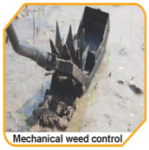 |
Top
|
Chemical weed control
Using chemicals, generally referred as herbicides, for the control of weeds is called chemical weed control.
Herbicide application can provide the most effective and time-efficient method of managing weeds.
Tamil Nadu and Kerala
Transplanted rice:
Pre-emergence herbicides
- Use Butachlor 1.25 kg/ha or Anilophos 0.4 kg/ha, Thiobencarb 50 % EC @ 2 kg/ha (1 kg ai/ha), pendimethalin
30 % EC @ 4.5 kg/ha (1.5 kg ai /ha), as pre-emergence application. Alternatively, pre-emergence application of
herbicide mixture viz., Butachlor 0.6 kg + 2, 4 DEE 0.75 kg/ha, or Anilophos + 2,4 DEE ‘ready-mix’ at 0.4 kg/ha
followed by one hand weeding on 30-35 DAT will have a broad spectrum of weed control.
- Any herbicide has to be mixed with 50 kg dry sand on the day of application (3-4 DAT) and applied uniformly in the
field with thin film water on the 3rd DAT. Water should not be drained for next 2 days from the field (or) fresh irrigation should not be given.
|
Post – emergence herbicides
- Where broad-leaved weeds and sedges are predominant, apply 2,4-D sodium salt (Fernoxone 80% WP) 1.25 kg/ha dissolved in 625 litres of water with a high volume sprayer, three weeks after transplanting or when the weeds are in 3-4 leaf stage.
Wet seeded rice
Spray any of the following herbicides:
- Butachlor 50% EC @ 2.5 kg/ha (1.25 kg ai/ha) or Thiobencarb 50% EC @ 2 kg/ha (1.00 kg ai/ha) 6-9 days after sowing
- Pretilachlor + safener (sofit) 50% EC@ 2.25 kg/ha (0.45 kg ai/ha) 3-5 days after sowing. Give a follow up application of
2,4-D 3.8% EC @ 3.04 kg/ha (0.8 kg ai/ha) at 20 days after sowing.
- To control Echinochloa sp. spray cyhalofop butyl 10% EW @ 0.8 kg/ha (0.08 kg ai/ha) at 15-18 days after sowing.
Dry seeded rice
Spray any of the following pre-emergent herbicides:
Thiobencarb 50% EC @ 3 kg/ha (1.5 kg ai/ha), butachlor 50 % EC @ 2.5 kg/ha (1.25 kg ai/ha), oxyfluorfen 4% EC @
6 kg/ha (0.15 kg ai/ha), pendimethalin 30% EC @ 4.5 kg/ha (1.50 kg ai/ha), pretilachlor 50% EC @ 3.75 kg/ha
(0.75 kg ai/ha) on the same day of seeding or within six days of seeding. |
Recommendations for Karnataka
Take up hand weeding at 20 and 40 days after transplanting and at 20 and 40 days after sowing in transplanted and drill sown Paddy respectively. |
 
|
Herbicide |
Quantity (ha) |
Time of application |
Remarks |
Transplanted Paddy - |
2, 4- D Sodium salt
80 % |
2.5 kg |
3 - 4 weeks after transplanting |
We can control dicotyledonous weeds and annual grasses. |
| Propanil 35 EC |
7.5 lit |
weeds are at 1 or 2 leaf stage |
We can control both monocotyledonous and dicotyledonous weeds. |
| Butachlor 5 % G |
30 kg |
Broadcast the granules at 5 - 7 days after transplanting |
- |
| 2,4 - D ethyl ester 5 % G |
15 kg |
Spray 5 - 7 days after transplanting |
- |
| Anilogard |
1.5 lit |
--do-- |
- |
| Thiobencarb 50 EC |
4.0 lit |
Within 5 days after transplanting |
- |
| Pendimethalin 30 EC |
3.3 lit |
Within 3 - 5 days after transplanting |
- |
| Oxidiazon 25 EC |
1.0 lit |
Within 3 - 5 days after transplanting |
- |
| Drill sown paddy |
| Propanil 35 EC |
7.5 lit |
Spray on weeds at 4 weeks after sowing |
We can control both monocotyledonous and dicotyledonous weeds. |
| Butachlor 50 EC |
3.0 lit |
Within 5 days after sowing |
- |
| Pendimethalin 30 EC |
3.3 lit |
Within 5 days after sowing |
Controls weeds belongs to Graminae family |
|
|
Biological weed control
- Use of living organisms viz., insects, disease organisms, herbivorous fish, snails or even competitive plants for the
control of weeds is called biological control.
- In biological control method, it is not possible to eradicate weeds but weed population can be reduced.
Hirschmanniella spinicaudata is a rice root nematode which controls most upland rice weed.
- Bactra verutana - a moth destroys Cyperus rotundus.
- Ludiwigia parviflora is completely destroyed by Altica cynanea (steel blue beetle)
|
|
| Top |
| Integrated Weed Management |
|
Integrated weed management (IWM) involves the concept of multiple tactics of weed management, maintenance of weed population below economic injury level and conservation of environment quality. A successful IWM strategy has the principles of enhancing farmer’s profitability, environmental protection and responsiveness to consumer preference. |
 |
Major components of IWM are
- Monitoring weeds, shift in weed flora, appearance of resistant weeds and introduction of new weeds.
- Emphasis on ecological, biological and biotechnological methods for environmental safety.
- Low cost agronomic technology for weed management in IWM system:
>> Stale seedbed
>> Balanced fertilizer use
>> Higher plant population
>> Intercropping / relay cropping
>> Use of competitive cultivars
>> Supplemental herbicide use at minimum possible rate.
Wet seeded rice
- Pre-emergence application of Pretilachlor 0.75 kg/ha or Butachlor 1.0 kg/ha on 8 DAS or Pretilachlor + safener (Soft) at 0.45 kg/ha on 3-4 DAS followed by one hand weeding on 40 DAS.
- Alternatively post-emergence application of Almix 4g/ha + 0.2 % surfactant at 20 DAS followed by one hand weeding on 40 DAS.
Rainfed rice
- Apply pendimethalin 1.0kg/ha on 5 days after sowing or Pretilachlor + safener (Sofit) 0.45kg/ha on the day of receipt of soaking rain followed by one hand weeding on 30 to 35 days after sowing.
|
|
| Top |
| |
Special Practices for Kerala |

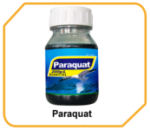
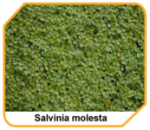
|
In certain areas like Kuttanad, wild rice has become a menace in recent years. The following agronomic practices can successfully control the infestation of wild rice.
-
Coat dry seeds with 20% calcium peroxide using 4% PVA solution as an adhesive and then
broadcast in the field with 10-15 cm column of standing water.
-
Maintain the water level for 10-12 days to prevent germination of wild rice.
-
Drain the field and apply N and K fertilizer as per recommendation for rapid growth of the rice seedlings.
Control of Salvinia molesta (African payal)
-
Trampling salvinia in situ in the wet lands a week before transplanting will control the weed and add to soil fertility.
-
For chemical control of salvinia, spray paraquat 42% TP @ 3.15 kg/ha (0.75 kg ai/ha).
|
|
| Top |
|